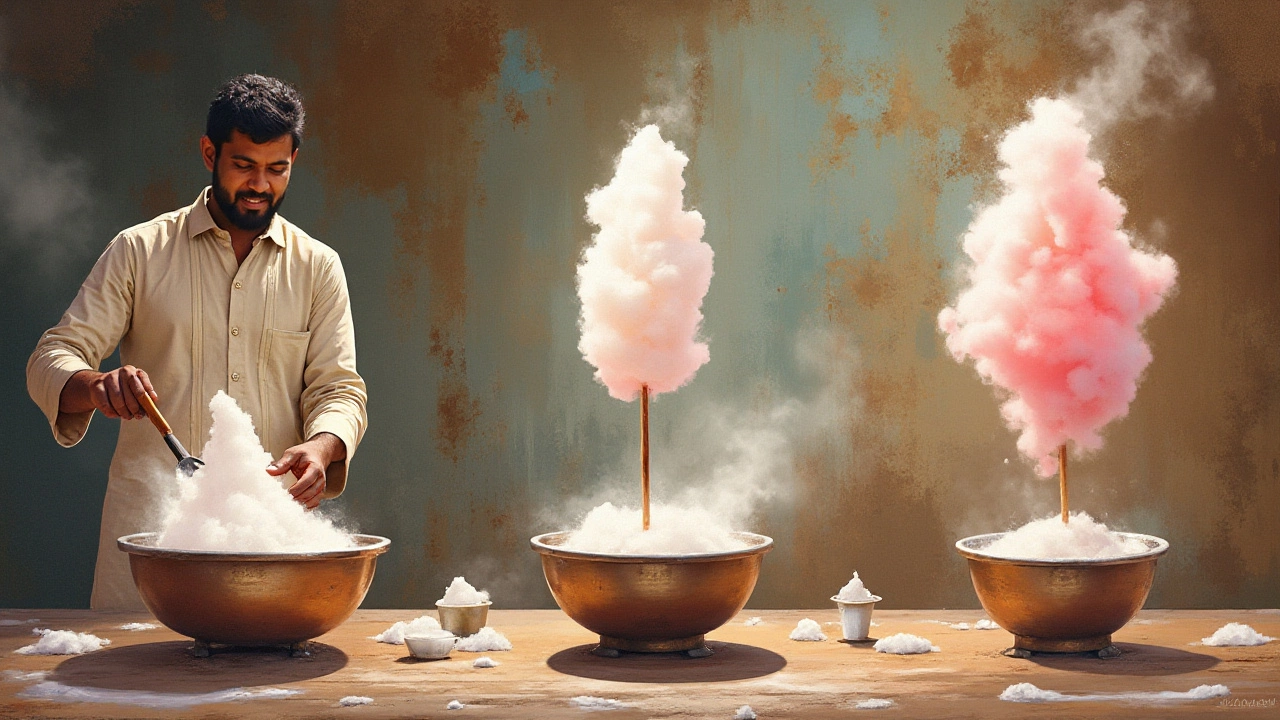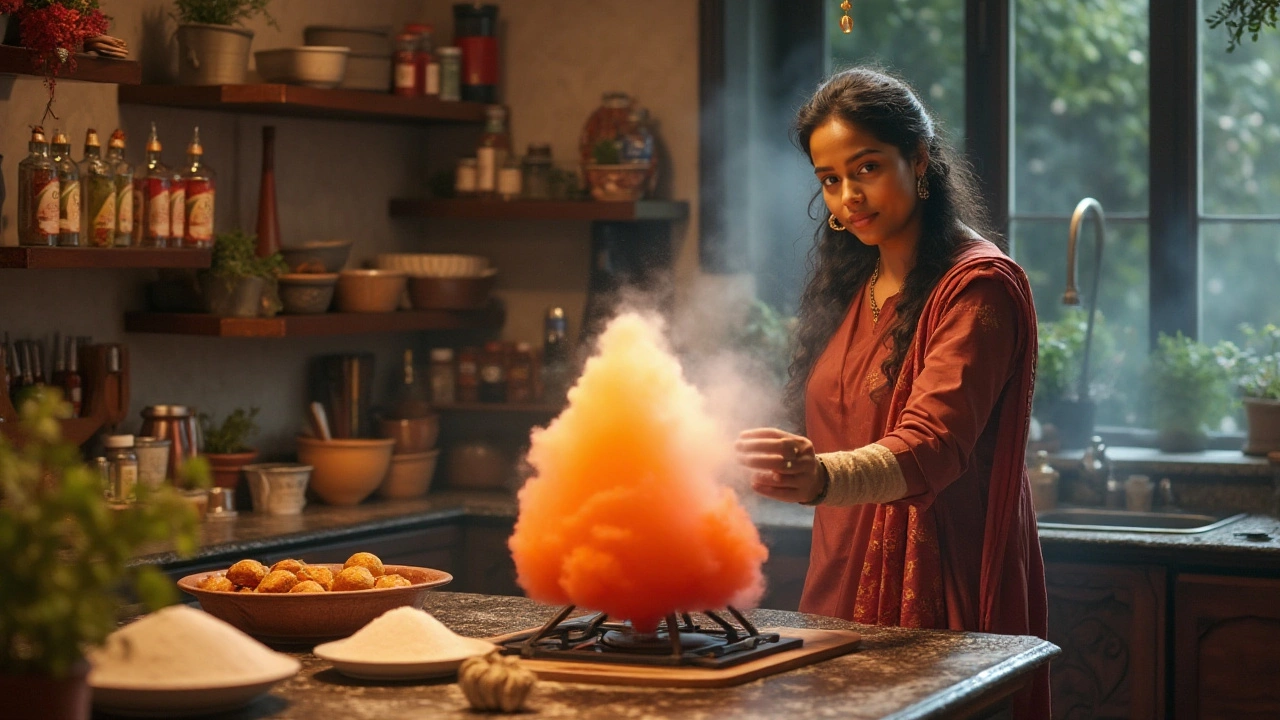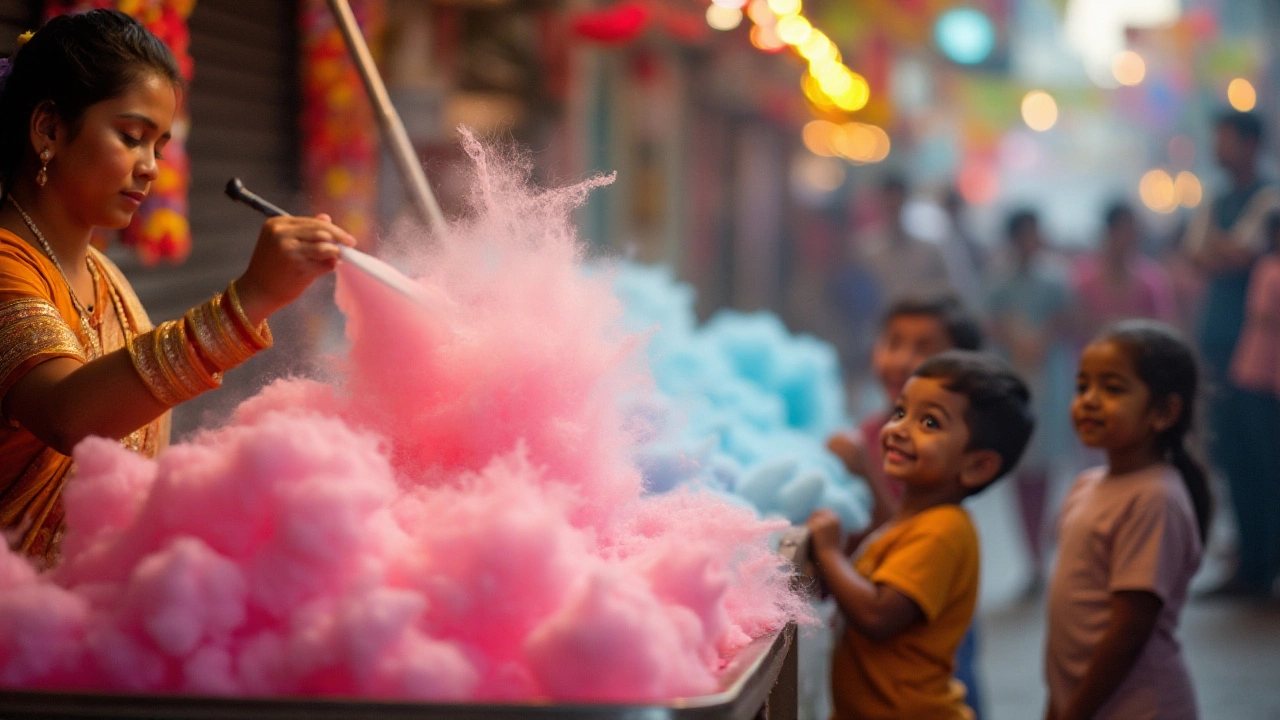Indian dessert candy floss is not just a sweet treat; it's a nostalgic journey wrapped in sugary threads. Known for its delightful fluffiness, this confectionery marvel has a story that stretches back through centuries and across continents. Unlike the typical fairground candy floss, the Indian variant promises a whirlwind of flavors and a dash of tradition in every bite.
This treat, often seen in vibrant colors at markets and festivals, captures the essence of sweetness with a textural twist. Making Indian candy floss involves an intriguing blend of culinary artistry and scientific transformation, turning simple sugar into something magical. Let's embark on a flavorful exploration, uncovering the secrets behind this airy creation and how you can bring a piece of this cultural indulgence to your own kitchen.
Origins of Indian Candy Floss
Indian candy floss, often charmingly called 'buddhi ka baal' or 'baba ka dhaba', presents a delightful fusion of sweet simplicity and rich cultural history. Although many might associate candy floss with bustling carnivals and western fairs, its roots dig deep into the diverse traditions of India. This sugary marvel came to light differently in various regions, each with its nuance, adding a bit of local flair. Its presence at Indian marketplaces and joyful celebrations, such as Diwali and Holi, speaks volumes of its embedded place in cultural fabric.
The journey of Indian sweets is fascinating, stretching back to ancient times when artisans manipulated sugar to create intricate designs and delightful textures. What distinguishes Indian candy floss from its western counterpart is not merely the flavor but perhaps the spice of nostalgia, as many adults today fondly remember the swirling paper cones filled with colorful spun sugar from their childhood days.
"Sugar is the missing element of every compelling folklore," remarked renowned culinary historian, Pushpesh Pant, emphasizing the emotional bonds formed with these humble sweets throughout history.
Tracing the origins of candy floss requires following the trails of sugar, which indeed has an intricate history within India. The country has been pivotal in the development of sugar processing techniques since the Gupta dynasty, making it a land pioneering culinary innovations. As society evolved, so did the treats. The development of sugar spinning techniques made it possible to create airy textures that resembled threads of hair, thus the whimsical name. Incredibly intricate and deceptively simple seeming, this confection captured the imaginations of young hearts and trained chefs alike, making it a staple no festival felt complete without.
It's important to recognize how advancements in sugar technology and craftsmanship elevated candy floss from being just a sweet treat to being an art form that exhibits the sheer ability of time-honored kitchens in upholding a legacy. The secret-like recipes hidden within family traditions show how deeply Indian desserts tie food with emotions. Today, Indian candy floss, with its enchanting threads, captures the zest of life, creating bridges between past and present, exhibiting the country's knack for turning simple elements into a sublime delight.

The Art of Preparation
Creating the exquisite Indian sweets known as candy floss is both an art and a science, a process that transforms mundane sugar crystals into a fluffy, ethereal delicacy that captivates the senses. It all begins with a simple yet crucial ingredient: sugar. Traditionally, the process begins by melting sugar until it reaches a specific temperature that allows it to become elastic while remaining tender. The molten sugar, often infused with vibrant food coloring or subtle flavors like rose or cardamom, is a glimpse into the playful versatility of this sweet treat. As the mixture heats, magic happens. The sugar molecules stretch and expand, preparing for the dramatic transformation that awaits.
The technique employed takes a cue from the classic candy-making tradition, where artisans skillfully pour the hot, viscous sugar over a spinning bowl, creating long, wispy strands that cool and solidify almost instantly. These strands are then gathered together to form that familiar cloud-like texture synonymous with candy floss. A true artisan knows the importance of getting the texture just right; it's a delicate balance that requires both patience and practice. There's an old saying among candy makers that "sugar heats slowly and cools quickly"— a reminder of how critical timing is in this process. A respected confectioner once remarked, "Making candy floss is like sculpting with sugar; every strand matters," emphasizing the level of skill involved in this ancient craft.
For those looking to recreate this magic at home, modern-day technology and a bit of practice can make it possible. Home candy floss machines simplify the process significantly, but understanding the artistry behind the tradition adds an extra layer of appreciation. Begin with an even batch of sugar, ensuring it is free of clumps to prevent uneven spinning. Once the machine is warmed up, pour in the sugar slowly and watch as it transforms into a floating cloud of sweetness. Wrapping these strands around a stick takes practice — much like weaving intricate patterns, each turn and twist adds to the final texture and appearance. When crafting your own candy floss, patience is vital, and sometimes the simplest adjustments yield the best results.
Though this dessert might seem simplistic on the surface, its roots run deep, intertwining with cultures worldwide. Many enthusiasts are surprised to learn that similar methods were used in ancient civilizations, from the Turks' 'pishmaniye' to the Chinese's 'Dragon's Beard candy,' each boasting unique spins on spun sugar delights. For each variant, the essence remains the same—transforming sugar into something extraordinarily delicious and joyous. Despite the technological advancements in candy-making, the sense of wonder when watching sugar transform into candy floss remains unchanged, reminding us of the ingenuity and simplicity that defines Indian dessert creations.

Global Connections
The allure of candy floss is a tapestry woven globally, connecting cultures through a shared love for spun sugar. While the Indian version holds a special place, its international siblings add a rich texture to its story. Let's explore these sweet analogs that have charmed taste buds across the globe. Perhaps the most widely recognized cousin of India's cotton candy is the American fairground treat, often conjured up alongside memories of summer carnivals and childhood joy. This version, known simply as cotton candy, is an innovation tracing back to the 1800s when a dentist and a confectioner came together to delight the masses with sweet, airy fluff.
Across the ocean, in Italy, a similar confection called 'zucchero filato' captures the Italian spirit with its traditional flavors and festive presence. The artistry in Italy's version lies in the incorporation of cross-regional ingredients, offering a sweet experience with subtle nuances. Despite geographical divides, the essence of these cloud-like desserts aligns in their ability to evoke nostalgia and create shared happiness. Not too far away, in Turkey, a spun sugar variant known as 'pişmaniye' tantalizes with its signature nutty essence woven into every strand. Turkish artisans craft this delicacy with a meticulous balance of sugar and flour, highlighting the region's culinary innovation.
Each country brings its unique twist to candy floss, and while the core concept may remain the same, the soul of each version is distinct, flavored by cultural nuances and local palates. An interesting development in recent years is the fusion of these traditional delights with modern culinary trends. In an era where desserts are as much about innovation as they are about taste, candy floss has not been left behind. Michelin-starred restaurants and avant-garde chefs around the world are re-imagining this classic treat, incorporating elements like edible flower petals, exotic spices, and even artisanal spirits. Such creative endeavors serve to remind us of the unifying power of sweetness. The inherent versatility of candy floss proves it to be an eternal canvas for cultural creativity, bridging ancient traditions with contemporary gustatory adventures.
"Candy floss, in all its global avatars, is a testament to the universal love for simple pleasures," notes food historian, Dr. Elisa Romano. "It's a culinary art form that transcends borders, telling a story of shared happiness through something as ephemeral as spun sugar."

Creating Your Own at Home
Crafting your own Indian candy floss at home may seem like a formidable task, but with a little guidance, it's an adventure worth taking. The process begins with gathering your ingredients, which are essentially simple: sugar, water, and food coloring for vibrancy. The real challenge lies in the technique, where patience and precision are your best allies. You'll need a sturdy pot, a candy thermometer, and a bit of practice to perfect the texture that makes this treat so beloved. Many have found that adding a pinch of flavored essence can elevate the experience, making your homemade creation a personalized delight.
Begin your journey by combining sugar and water in the pot, gently heating it until the sugar dissolves completely. Monitoring the temperature is crucial, as reaching the right degree—specifically between 320 to 350 degrees Fahrenheit—determines the success of achieving that airy structure characteristic of candy floss. Make sure not to stir during the heating process, as this can cause crystallization, leading to a grainy texture. Instead, gentle swirling of the pot helps maintain even heat distribution. Once the desired temperature is reached, a quick dip of your fingers (cautiously tested under cold water) should yield threads that easily break, signaling readiness.
"It's about the way sugar weaves into something light and ethereal; that moment of alchemy when simplicity morphs into spectacle," remarks renowned confectioner Mira Kapur, whose expertise in Indian sweets is celebrated worldwide.
Once you've prepared the sugar solution, the fun begins. You can opt for two methods to create your flossy magic. The traditional way involves using slender, wooden sticks dipped and twirled into the sugar concoction as it begins to set, careful to stretch and fold the strands into delicate nests. Alternatively, you might experiment with a home candy floss machine if you're a frequent aficionado of this delightful Indian sweet. Regardless of the method, practice and patience are key. To truly savor this experience, try creating candy floss as part of a family gathering or festival, embodying the spirit of India's communal enjoyment of sweets.
Feel free to experiment with colors and flavors—let your culinary creativity flow. In India, subtle hints of cardamom or rose are often infused to complement the sweetness, adding a unique aroma and taste. This fusion of tradition with personal innovation can be seen in festivals and street fairs. Once you've achieved candy floss with that iconic texture and flavor, it's time to share it with others, making it a centerpiece of your next celebration. For those ambitious souls, here’s a tip: drizzling melted chocolate over the finished product, and serving it alongside fresh citrus fruits can offer a gourmet twist, adding depth to your dessert recipes repertoire.
